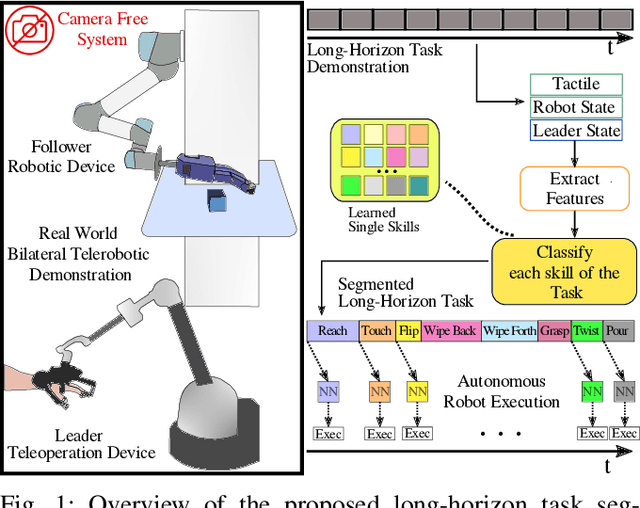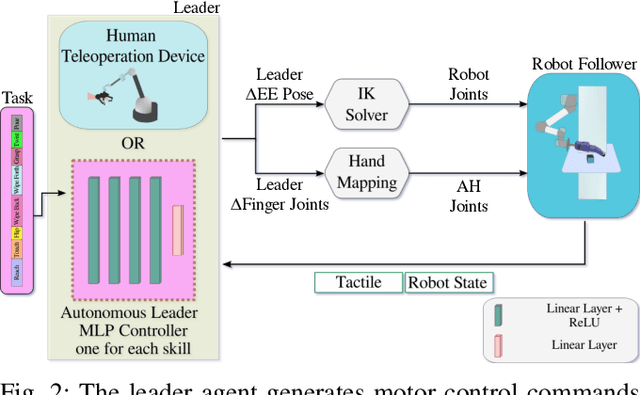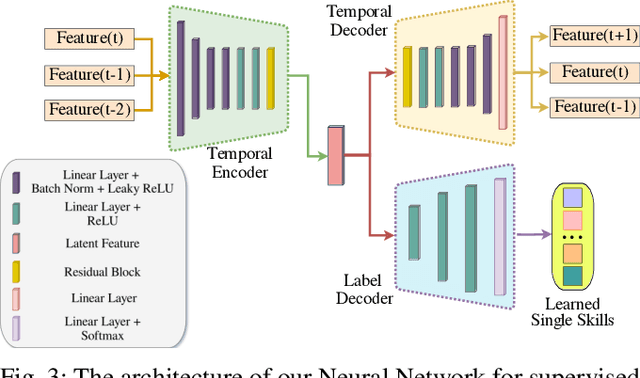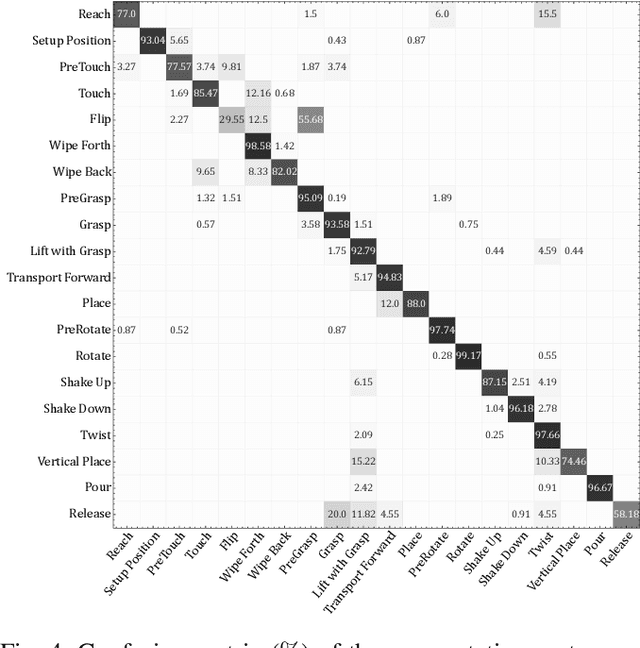Xiaofeng Mao
Sekai: A Video Dataset towards World Exploration
Jun 18, 2025Abstract:Video generation techniques have made remarkable progress, promising to be the foundation of interactive world exploration. However, existing video generation datasets are not well-suited for world exploration training as they suffer from some limitations: limited locations, short duration, static scenes, and a lack of annotations about exploration and the world. In this paper, we introduce Sekai (meaning ``world'' in Japanese), a high-quality first-person view worldwide video dataset with rich annotations for world exploration. It consists of over 5,000 hours of walking or drone view (FPV and UVA) videos from over 100 countries and regions across 750 cities. We develop an efficient and effective toolbox to collect, pre-process and annotate videos with location, scene, weather, crowd density, captions, and camera trajectories. Experiments demonstrate the quality of the dataset. And, we use a subset to train an interactive video world exploration model, named YUME (meaning ``dream'' in Japanese). We believe Sekai will benefit the area of video generation and world exploration, and motivate valuable applications.
TRIDENT: Enhancing Large Language Model Safety with Tri-Dimensional Diversified Red-Teaming Data Synthesis
May 30, 2025Abstract:Large Language Models (LLMs) excel in various natural language processing tasks but remain vulnerable to generating harmful content or being exploited for malicious purposes. Although safety alignment datasets have been introduced to mitigate such risks through supervised fine-tuning (SFT), these datasets often lack comprehensive risk coverage. Most existing datasets focus primarily on lexical diversity while neglecting other critical dimensions. To address this limitation, we propose a novel analysis framework to systematically measure the risk coverage of alignment datasets across three essential dimensions: Lexical Diversity, Malicious Intent, and Jailbreak Tactics. We further introduce TRIDENT, an automated pipeline that leverages persona-based, zero-shot LLM generation to produce diverse and comprehensive instructions spanning these dimensions. Each harmful instruction is paired with an ethically aligned response, resulting in two datasets: TRIDENT-Core, comprising 26,311 examples, and TRIDENT-Edge, with 18,773 examples. Fine-tuning Llama 3.1-8B on TRIDENT-Edge demonstrates substantial improvements, achieving an average 14.29% reduction in Harm Score, and a 20% decrease in Attack Success Rate compared to the best-performing baseline model fine-tuned on the WildBreak dataset.
EVOREFUSE: Evolutionary Prompt Optimization for Evaluation and Mitigation of LLM Over-Refusal to Pseudo-Malicious Instructions
May 29, 2025Abstract:Large language models (LLMs) frequently refuse to respond to pseudo-malicious instructions: semantically harmless input queries triggering unnecessary LLM refusals due to conservative safety alignment, significantly impairing user experience. Collecting such instructions is crucial for evaluating and mitigating over-refusals, but existing instruction curation methods, like manual creation or instruction rewriting, either lack scalability or fail to produce sufficiently diverse and effective refusal-inducing prompts. To address these limitations, we introduce EVOREFUSE, a prompt optimization approach that generates diverse pseudo-malicious instructions consistently eliciting confident refusals across LLMs. EVOREFUSE employs an evolutionary algorithm exploring the instruction space in more diverse directions than existing methods via mutation strategies and recombination, and iteratively evolves seed instructions to maximize evidence lower bound on LLM refusal probability. Using EVOREFUSE, we create two novel datasets: EVOREFUSE-TEST, a benchmark of 582 pseudo-malicious instructions that outperforms the next-best benchmark with 140.41% higher average refusal triggering rate across 9 LLMs, 34.86% greater lexical diversity, and 40.03% improved LLM response confidence scores; and EVOREFUSE-ALIGN, which provides 3,000 pseudo-malicious instructions with responses for supervised and preference-based alignment training. LLAMA3.1-8B-INSTRUCT supervisedly fine-tuned on EVOREFUSE-ALIGN achieves up to 14.31% fewer over-refusals than models trained on the second-best alignment dataset, without compromising safety. Our analysis with EVOREFUSE-TEST reveals models trigger over-refusals by overly focusing on sensitive keywords while ignoring broader context.
MDK12-Bench: A Multi-Discipline Benchmark for Evaluating Reasoning in Multimodal Large Language Models
Apr 08, 2025Abstract:Multimodal reasoning, which integrates language and visual cues into problem solving and decision making, is a fundamental aspect of human intelligence and a crucial step toward artificial general intelligence. However, the evaluation of multimodal reasoning capabilities in Multimodal Large Language Models (MLLMs) remains inadequate. Most existing reasoning benchmarks are constrained by limited data size, narrow domain coverage, and unstructured knowledge distribution. To close these gaps, we introduce MDK12-Bench, a multi-disciplinary benchmark assessing the reasoning capabilities of MLLMs via real-world K-12 examinations. Spanning six disciplines (math, physics, chemistry, biology, geography, and information science), our benchmark comprises 140K reasoning instances across diverse difficulty levels from primary school to 12th grade. It features 6,827 instance-level knowledge point annotations based on a well-organized knowledge structure, detailed answer explanations, difficulty labels and cross-year partitions, providing a robust platform for comprehensive evaluation. Additionally, we present a novel dynamic evaluation framework to mitigate data contamination issues by bootstrapping question forms, question types, and image styles during evaluation. Extensive experiment on MDK12-Bench reveals the significant limitation of current MLLMs in multimodal reasoning. The findings on our benchmark provide insights into the development of the next-generation models. Our data and codes are available at https://github.com/LanceZPF/MDK12.
Learning Long-Horizon Robot Manipulation Skills via Privileged Action
Feb 21, 2025Abstract:Long-horizon contact-rich tasks are challenging to learn with reinforcement learning, due to ineffective exploration of high-dimensional state spaces with sparse rewards. The learning process often gets stuck in local optimum and demands task-specific reward fine-tuning for complex scenarios. In this work, we propose a structured framework that leverages privileged actions with curriculum learning, enabling the policy to efficiently acquire long-horizon skills without relying on extensive reward engineering or reference trajectories. Specifically, we use privileged actions in simulation with a general training procedure that would be infeasible to implement in real-world scenarios. These privileges include relaxed constraints and virtual forces that enhance interaction and exploration with objects. Our results successfully achieve complex multi-stage long-horizon tasks that naturally combine non-prehensile manipulation with grasping to lift objects from non-graspable poses. We demonstrate generality by maintaining a parsimonious reward structure and showing convergence to diverse and robust behaviors across various environments. Additionally, real-world experiments further confirm that the skills acquired using our approach are transferable to real-world environments, exhibiting robust and intricate performance. Our approach outperforms state-of-the-art methods in these tasks, converging to solutions where others fail.
OSV: One Step is Enough for High-Quality Image to Video Generation
Sep 17, 2024



Abstract:Video diffusion models have shown great potential in generating high-quality videos, making them an increasingly popular focus. However, their inherent iterative nature leads to substantial computational and time costs. While efforts have been made to accelerate video diffusion by reducing inference steps (through techniques like consistency distillation) and GAN training (these approaches often fall short in either performance or training stability). In this work, we introduce a two-stage training framework that effectively combines consistency distillation with GAN training to address these challenges. Additionally, we propose a novel video discriminator design, which eliminates the need for decoding the video latents and improves the final performance. Our model is capable of producing high-quality videos in merely one-step, with the flexibility to perform multi-step refinement for further performance enhancement. Our quantitative evaluation on the OpenWebVid-1M benchmark shows that our model significantly outperforms existing methods. Notably, our 1-step performance(FVD 171.15) exceeds the 8-step performance of the consistency distillation based method, AnimateLCM (FVD 184.79), and approaches the 25-step performance of advanced Stable Video Diffusion (FVD 156.94).
VI3DRM:Towards meticulous 3D Reconstruction from Sparse Views via Photo-Realistic Novel View Synthesis
Sep 12, 2024



Abstract:Recently, methods like Zero-1-2-3 have focused on single-view based 3D reconstruction and have achieved remarkable success. However, their predictions for unseen areas heavily rely on the inductive bias of large-scale pretrained diffusion models. Although subsequent work, such as DreamComposer, attempts to make predictions more controllable by incorporating additional views, the results remain unrealistic due to feature entanglement in the vanilla latent space, including factors such as lighting, material, and structure. To address these issues, we introduce the Visual Isotropy 3D Reconstruction Model (VI3DRM), a diffusion-based sparse views 3D reconstruction model that operates within an ID consistent and perspective-disentangled 3D latent space. By facilitating the disentanglement of semantic information, color, material properties and lighting, VI3DRM is capable of generating highly realistic images that are indistinguishable from real photographs. By leveraging both real and synthesized images, our approach enables the accurate construction of pointmaps, ultimately producing finely textured meshes or point clouds. On the NVS task, tested on the GSO dataset, VI3DRM significantly outperforms state-of-the-art method DreamComposer, achieving a PSNR of 38.61, an SSIM of 0.929, and an LPIPS of 0.027. Code will be made available upon publication.
MDT-A2G: Exploring Masked Diffusion Transformers for Co-Speech Gesture Generation
Aug 06, 2024



Abstract:Recent advancements in the field of Diffusion Transformers have substantially improved the generation of high-quality 2D images, 3D videos, and 3D shapes. However, the effectiveness of the Transformer architecture in the domain of co-speech gesture generation remains relatively unexplored, as prior methodologies have predominantly employed the Convolutional Neural Network (CNNs) or simple a few transformer layers. In an attempt to bridge this research gap, we introduce a novel Masked Diffusion Transformer for co-speech gesture generation, referred to as MDT-A2G, which directly implements the denoising process on gesture sequences. To enhance the contextual reasoning capability of temporally aligned speech-driven gestures, we incorporate a novel Masked Diffusion Transformer. This model employs a mask modeling scheme specifically designed to strengthen temporal relation learning among sequence gestures, thereby expediting the learning process and leading to coherent and realistic motions. Apart from audio, Our MDT-A2G model also integrates multi-modal information, encompassing text, emotion, and identity. Furthermore, we propose an efficient inference strategy that diminishes the denoising computation by leveraging previously calculated results, thereby achieving a speedup with negligible performance degradation. Experimental results demonstrate that MDT-A2G excels in gesture generation, boasting a learning speed that is over 6$\times$ faster than traditional diffusion transformers and an inference speed that is 5.7$\times$ than the standard diffusion model.
S-Eval: Automatic and Adaptive Test Generation for Benchmarking Safety Evaluation of Large Language Models
May 28, 2024Abstract:Large Language Models have gained considerable attention for their revolutionary capabilities. However, there is also growing concern on their safety implications, making a comprehensive safety evaluation for LLMs urgently needed before model deployment. In this work, we propose S-Eval, a new comprehensive, multi-dimensional and open-ended safety evaluation benchmark. At the core of S-Eval is a novel LLM-based automatic test prompt generation and selection framework, which trains an expert testing LLM Mt combined with a range of test selection strategies to automatically construct a high-quality test suite for the safety evaluation. The key to the automation of this process is a novel expert safety-critique LLM Mc able to quantify the riskiness score of an LLM's response, and additionally produce risk tags and explanations. Besides, the generation process is also guided by a carefully designed risk taxonomy with four different levels, covering comprehensive and multi-dimensional safety risks of concern. Based on these, we systematically construct a new and large-scale safety evaluation benchmark for LLMs consisting of 220,000 evaluation prompts, including 20,000 base risk prompts (10,000 in Chinese and 10,000 in English) and 200,000 corresponding attack prompts derived from 10 popular adversarial instruction attacks against LLMs. Moreover, considering the rapid evolution of LLMs and accompanied safety threats, S-Eval can be flexibly configured and adapted to include new risks, attacks and models. S-Eval is extensively evaluated on 20 popular and representative LLMs. The results confirm that S-Eval can better reflect and inform the safety risks of LLMs compared to existing benchmarks. We also explore the impacts of parameter scales, language environments, and decoding parameters on the evaluation, providing a systematic methodology for evaluating the safety of LLMs.
DexSkills: Skill Segmentation Using Haptic Data for Learning Autonomous Long-Horizon Robotic Manipulation Tasks
May 06, 2024



Abstract:Effective execution of long-horizon tasks with dexterous robotic hands remains a significant challenge in real-world problems. While learning from human demonstrations have shown encouraging results, they require extensive data collection for training. Hence, decomposing long-horizon tasks into reusable primitive skills is a more efficient approach. To achieve so, we developed DexSkills, a novel supervised learning framework that addresses long-horizon dexterous manipulation tasks using primitive skills. DexSkills is trained to recognize and replicate a select set of skills using human demonstration data, which can then segment a demonstrated long-horizon dexterous manipulation task into a sequence of primitive skills to achieve one-shot execution by the robot directly. Significantly, DexSkills operates solely on proprioceptive and tactile data, i.e., haptic data. Our real-world robotic experiments show that DexSkills can accurately segment skills, thereby enabling autonomous robot execution of a diverse range of tasks.
 Add to Chrome
Add to Chrome Add to Firefox
Add to Firefox Add to Edge
Add to Edge